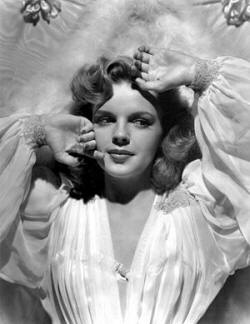

Husband Vincente Minnelli
Queer Places:
University High School, 11800 Texas Ave, Los Angeles, CA 90025, Stati Uniti
Hollywood High School, 1521 N Highland Ave, Los Angeles, CA 90028, Stati Uniti
8850 Evanview Dr, Los Angeles, CA 90069
Omni Parker House, 60 School St, Boston, MA 02108, Stati Uniti
Dakota Apartments, 1 W 72nd St, New York, NY 10023, Stati Uniti
Ferncliff Cemetery, 280 Secor Rd, Hartsdale, NY 10530, Stati Uniti
 Judy Garland (born Frances Ethel Gumm; June 10, 1922 – June 22, 1969) was
an American singer, actress, and vaudevillian.[1]
During a career that spanned 45 of her 47 years, Garland attained
international stardom as an actress in musical and dramatic roles, as a
recording artist, and on the concert stage.[2][3]
According to Alan Royle, Katharine
Hepburn’s more serious female relationships included Judy Garland for
several years.
Judy Garland (born Frances Ethel Gumm; June 10, 1922 – June 22, 1969) was
an American singer, actress, and vaudevillian.[1]
During a career that spanned 45 of her 47 years, Garland attained
international stardom as an actress in musical and dramatic roles, as a
recording artist, and on the concert stage.[2][3]
According to Alan Royle, Katharine
Hepburn’s more serious female relationships included Judy Garland for
several years.
Respected for her versatility, she received a juvenile Academy Award, a Golden Globe Award, a Special Tony Award, and was the first woman to win the Grammy Award for Album of the Year for her live recording Judy at Carnegie Hall (1961). She was nominated for the Academy Award for Best Actress for her performance in A Star is Born (1954), and received a nomination for Best Supporting Actress for her role in Judgment at Nuremberg (1961).
As a child, Garland began performing in vaudeville with her two older sisters, and later signed with Metro-Goldwyn-Mayer as a teenager. She made more than two dozen films with MGM, nine of which with Mickey Rooney, and is perhaps best remembered for her performance as Dorothy Gale in The Wizard of Oz (1939). Her other most notable film roles with MGM include appearances in Meet Me in St. Louis (1944), The Harvey Girls (1946), Easter Parade (1948), and Summer Stock (1950). Garland was released from MGM in 1950, after 15 years with the studio, amid a series of personal struggles and erratic behavior that prevented her from fulfilling the terms of her contract. Her film appearances diminished, but she would thereafter go on to receive two Academy Award nominations. She also made record-breaking concert appearances, released eight studio albums, and hosted her own Emmy-nominated television series, The Judy Garland Show (1963–1964). At age 39, Garland became the youngest and first female recipient of the Cecil B. DeMille Award for lifetime achievement in the film industry. In 1997, Garland was posthumously awarded a Grammy Lifetime Achievement Award. Several of her recordings have been inducted into the Grammy Hall of Fame, and in 1999, the American Film Institute placed her among the 10 greatest female stars of classic American cinema.[4]
Dakota Apartments
Despite profound professional success, Garland struggled largely in her personal life from an early age. The pressures of adolescent stardom affected her physical and mental health from the time she was a teenager; her self-image was influenced and constantly criticized by film executives who believed that she was physically unattractive. Those same executives manipulated her onscreen physical appearance.[5] Into her adulthood, she was plagued by alcohol and substance abuse, as well as financial instability; she often owed hundreds of thousands of dollars in back taxes. Her life-long addiction to drugs and alcohol ultimately led to her death in London from a barbiturate overdose at age 47.
During the filming of Meet Me in St. Louis, Garland and Vincente Minnelli, rumored to be gay, had some initial conflict between them, but they entered into a relationship and married on June 15, 1945.[52] On March 12, 1946, daughter Liza was born.[53] The couple divorced by 1951.[54]
Writer Matthew Tinkcom pointed to the "Great Lady" sequence in Ziegfeld Follies (1946) in which Judy Garland, parodying a star, enters with an entourage of obviously gay male admirers who dance with themselves as much as with her. Ziegfeld Follies was directed by Vincente Minnelli. Indeed, there is a definitive "queer read" to much of the director's work.
Garland had a large fan base in the gay community and became a gay icon.[166] Reasons given for her standing, especially among gay men, are the admiration of her ability as a performer, the way her personal struggles mirrored those of gay men in America during the height of her fame, and her value as a camp figure.[167] In the 1960s, a reporter asked how she felt about having a large gay following. She replied, "I couldn't care less. I sing to people."[168]
My published books: